Literature Review: Occupational Risk Assessment in Singapore
VerifiedAdded on 2023/06/10
|17
|3540
|143
Literature Review
AI Summary
This literature review examines the implementation and impact of risk assessment in Singapore, particularly within the context of workplace safety and health. It begins by introducing Singapore's industrial landscape and the Ministry of Manpower's framework for occupational safety standards. The review delves into the pros and cons of risk assessment, highlighting its importance in preventing accidents and meeting legal requirements, while also acknowledging potential costs and data dependencies. Key aspects of the risk assessment procedure, including hazard identification, risk evaluation, and control measures, are discussed in detail. The review also offers recommendations for improving risk assessment practices, such as regular monitoring, pre-employment training, and management attention. Alternative risk assessment ideas, like checklist analysis and safety audits, are also presented. The review concludes by reflecting on the learning outcomes and emphasizing the importance of risk assessment in creating a safer work environment.
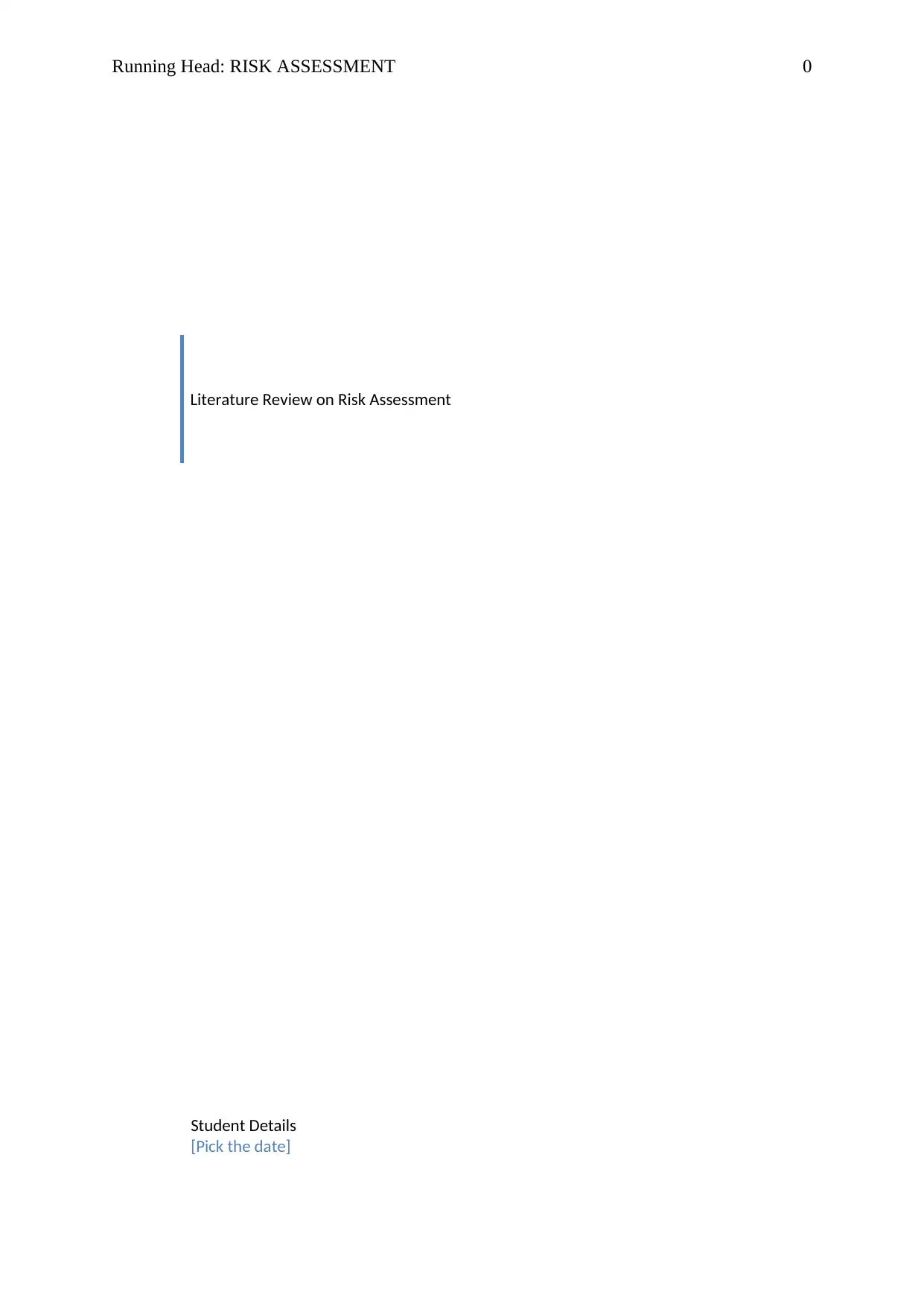
Running Head: RISK ASSESSMENT 0
Literature Review on Risk Assessment
Student Details
[Pick the date]
Literature Review on Risk Assessment
Student Details
[Pick the date]
Paraphrase This Document
Need a fresh take? Get an instant paraphrase of this document with our AI Paraphraser
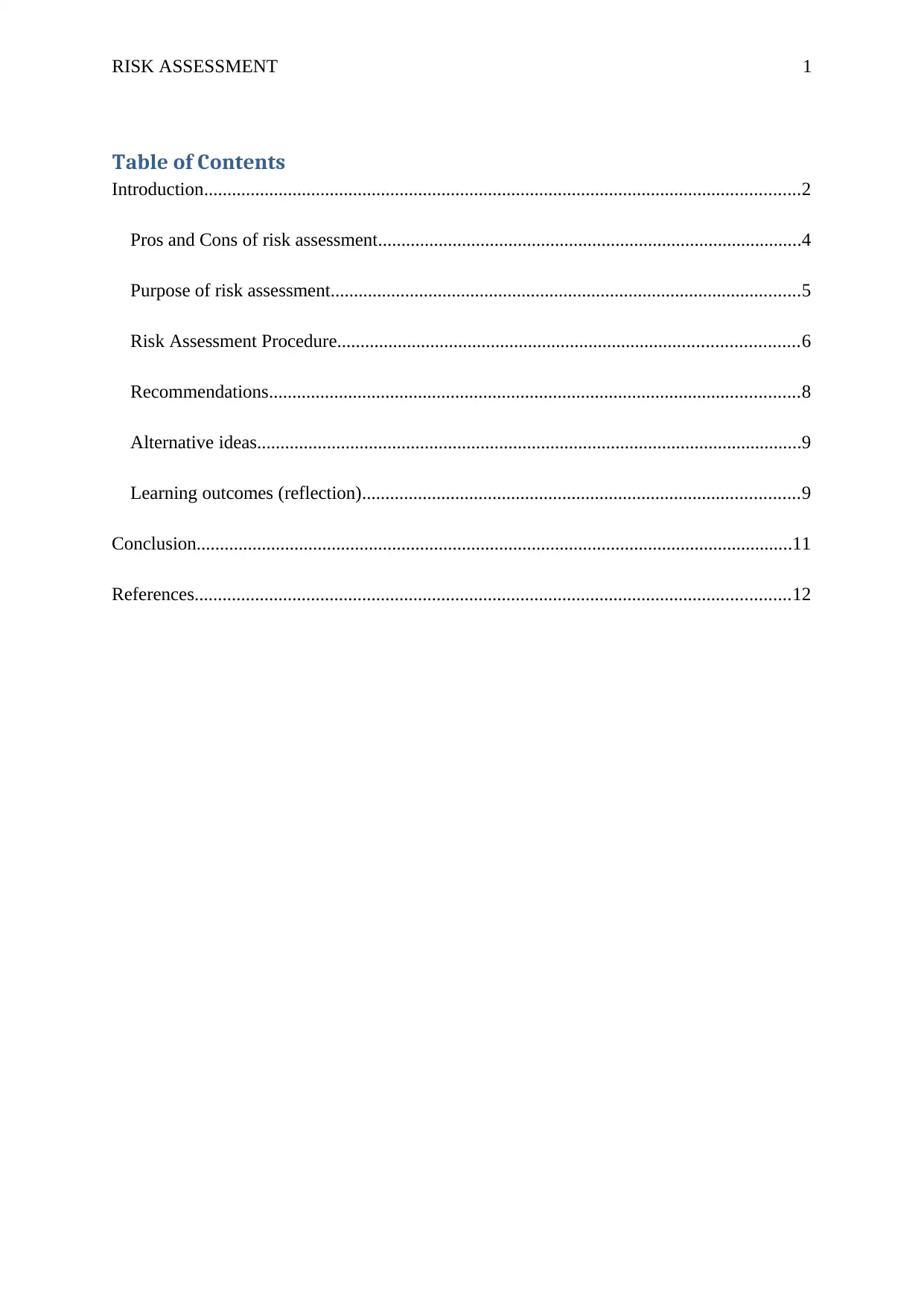
RISK ASSESSMENT 1
Table of Contents
Introduction................................................................................................................................2
Pros and Cons of risk assessment...........................................................................................4
Purpose of risk assessment.....................................................................................................5
Risk Assessment Procedure...................................................................................................6
Recommendations..................................................................................................................8
Alternative ideas.....................................................................................................................9
Learning outcomes (reflection)..............................................................................................9
Conclusion................................................................................................................................11
References................................................................................................................................12
Table of Contents
Introduction................................................................................................................................2
Pros and Cons of risk assessment...........................................................................................4
Purpose of risk assessment.....................................................................................................5
Risk Assessment Procedure...................................................................................................6
Recommendations..................................................................................................................8
Alternative ideas.....................................................................................................................9
Learning outcomes (reflection)..............................................................................................9
Conclusion................................................................................................................................11
References................................................................................................................................12
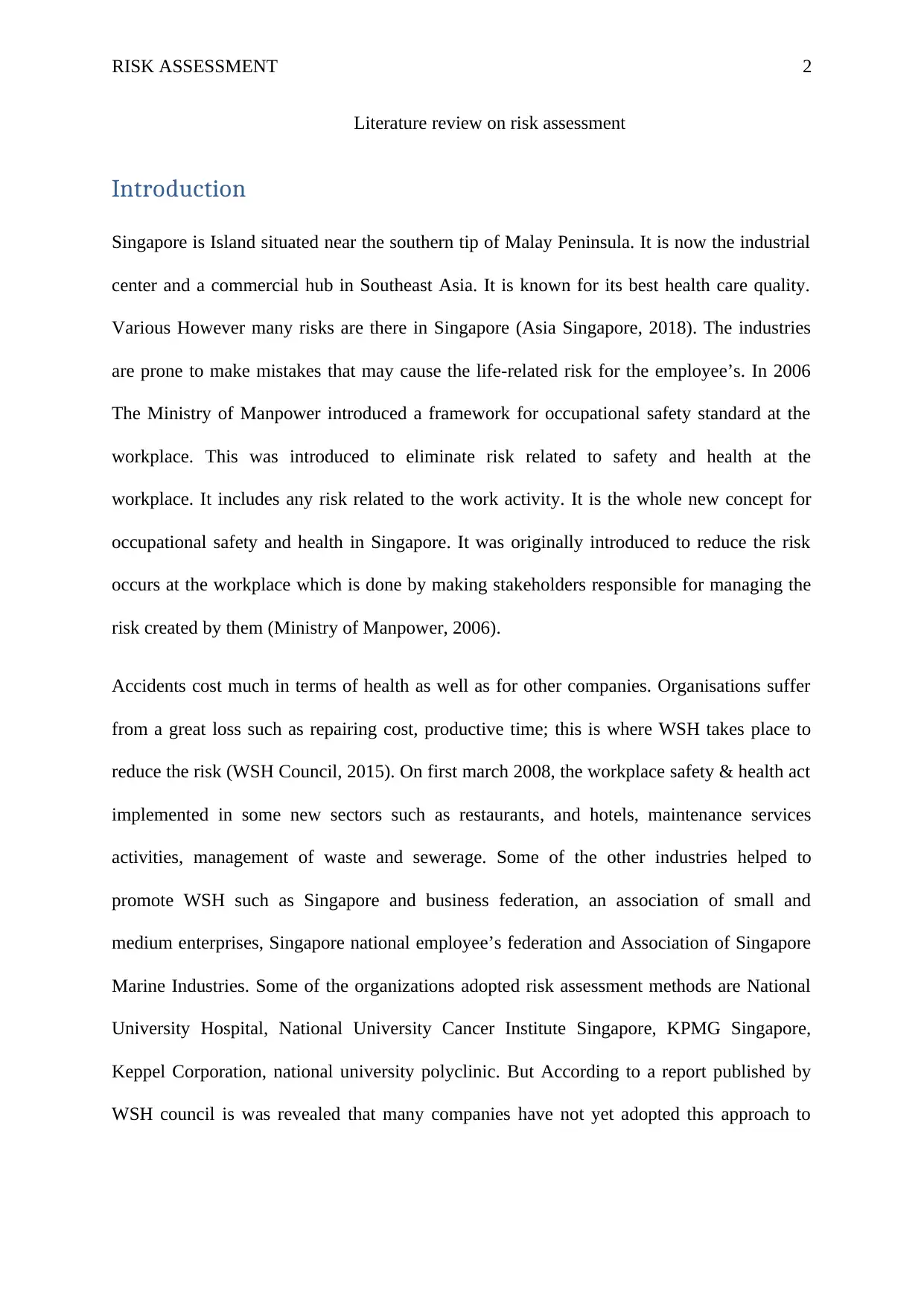
RISK ASSESSMENT 2
Literature review on risk assessment
Introduction
Singapore is Island situated near the southern tip of Malay Peninsula. It is now the industrial
center and a commercial hub in Southeast Asia. It is known for its best health care quality.
Various However many risks are there in Singapore (Asia Singapore, 2018). The industries
are prone to make mistakes that may cause the life-related risk for the employee’s. In 2006
The Ministry of Manpower introduced a framework for occupational safety standard at the
workplace. This was introduced to eliminate risk related to safety and health at the
workplace. It includes any risk related to the work activity. It is the whole new concept for
occupational safety and health in Singapore. It was originally introduced to reduce the risk
occurs at the workplace which is done by making stakeholders responsible for managing the
risk created by them (Ministry of Manpower, 2006).
Accidents cost much in terms of health as well as for other companies. Organisations suffer
from a great loss such as repairing cost, productive time; this is where WSH takes place to
reduce the risk (WSH Council, 2015). On first march 2008, the workplace safety & health act
implemented in some new sectors such as restaurants, and hotels, maintenance services
activities, management of waste and sewerage. Some of the other industries helped to
promote WSH such as Singapore and business federation, an association of small and
medium enterprises, Singapore national employee’s federation and Association of Singapore
Marine Industries. Some of the organizations adopted risk assessment methods are National
University Hospital, National University Cancer Institute Singapore, KPMG Singapore,
Keppel Corporation, national university polyclinic. But According to a report published by
WSH council is was revealed that many companies have not yet adopted this approach to
Literature review on risk assessment
Introduction
Singapore is Island situated near the southern tip of Malay Peninsula. It is now the industrial
center and a commercial hub in Southeast Asia. It is known for its best health care quality.
Various However many risks are there in Singapore (Asia Singapore, 2018). The industries
are prone to make mistakes that may cause the life-related risk for the employee’s. In 2006
The Ministry of Manpower introduced a framework for occupational safety standard at the
workplace. This was introduced to eliminate risk related to safety and health at the
workplace. It includes any risk related to the work activity. It is the whole new concept for
occupational safety and health in Singapore. It was originally introduced to reduce the risk
occurs at the workplace which is done by making stakeholders responsible for managing the
risk created by them (Ministry of Manpower, 2006).
Accidents cost much in terms of health as well as for other companies. Organisations suffer
from a great loss such as repairing cost, productive time; this is where WSH takes place to
reduce the risk (WSH Council, 2015). On first march 2008, the workplace safety & health act
implemented in some new sectors such as restaurants, and hotels, maintenance services
activities, management of waste and sewerage. Some of the other industries helped to
promote WSH such as Singapore and business federation, an association of small and
medium enterprises, Singapore national employee’s federation and Association of Singapore
Marine Industries. Some of the organizations adopted risk assessment methods are National
University Hospital, National University Cancer Institute Singapore, KPMG Singapore,
Keppel Corporation, national university polyclinic. But According to a report published by
WSH council is was revealed that many companies have not yet adopted this approach to
⊘ This is a preview!⊘
Do you want full access?
Subscribe today to unlock all pages.

Trusted by 1+ million students worldwide
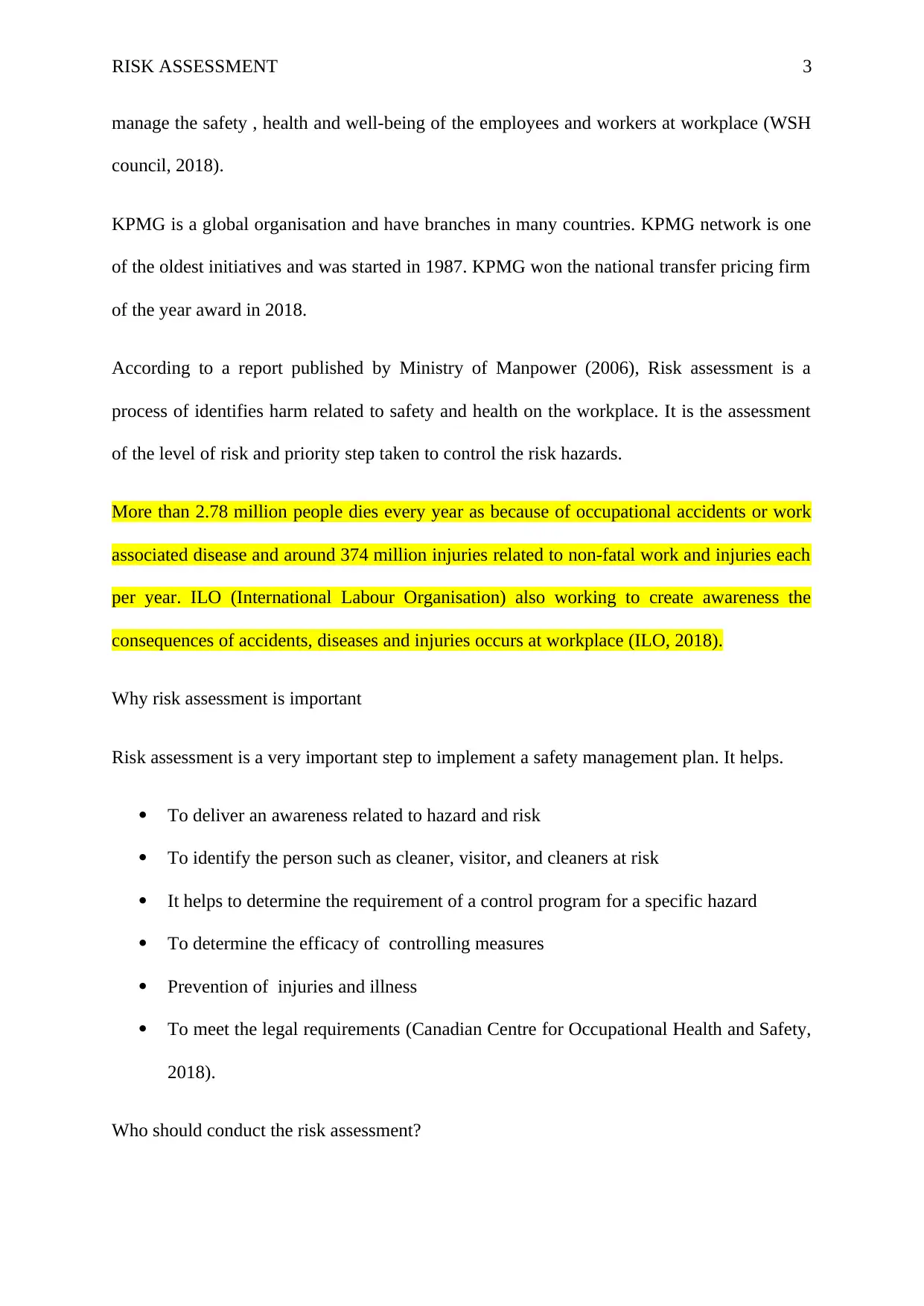
RISK ASSESSMENT 3
manage the safety , health and well-being of the employees and workers at workplace (WSH
council, 2018).
KPMG is a global organisation and have branches in many countries. KPMG network is one
of the oldest initiatives and was started in 1987. KPMG won the national transfer pricing firm
of the year award in 2018.
According to a report published by Ministry of Manpower (2006), Risk assessment is a
process of identifies harm related to safety and health on the workplace. It is the assessment
of the level of risk and priority step taken to control the risk hazards.
More than 2.78 million people dies every year as because of occupational accidents or work
associated disease and around 374 million injuries related to non-fatal work and injuries each
per year. ILO (International Labour Organisation) also working to create awareness the
consequences of accidents, diseases and injuries occurs at workplace (ILO, 2018).
Why risk assessment is important
Risk assessment is a very important step to implement a safety management plan. It helps.
To deliver an awareness related to hazard and risk
To identify the person such as cleaner, visitor, and cleaners at risk
It helps to determine the requirement of a control program for a specific hazard
To determine the efficacy of controlling measures
Prevention of injuries and illness
To meet the legal requirements (Canadian Centre for Occupational Health and Safety,
2018).
Who should conduct the risk assessment?
manage the safety , health and well-being of the employees and workers at workplace (WSH
council, 2018).
KPMG is a global organisation and have branches in many countries. KPMG network is one
of the oldest initiatives and was started in 1987. KPMG won the national transfer pricing firm
of the year award in 2018.
According to a report published by Ministry of Manpower (2006), Risk assessment is a
process of identifies harm related to safety and health on the workplace. It is the assessment
of the level of risk and priority step taken to control the risk hazards.
More than 2.78 million people dies every year as because of occupational accidents or work
associated disease and around 374 million injuries related to non-fatal work and injuries each
per year. ILO (International Labour Organisation) also working to create awareness the
consequences of accidents, diseases and injuries occurs at workplace (ILO, 2018).
Why risk assessment is important
Risk assessment is a very important step to implement a safety management plan. It helps.
To deliver an awareness related to hazard and risk
To identify the person such as cleaner, visitor, and cleaners at risk
It helps to determine the requirement of a control program for a specific hazard
To determine the efficacy of controlling measures
Prevention of injuries and illness
To meet the legal requirements (Canadian Centre for Occupational Health and Safety,
2018).
Who should conduct the risk assessment?
Paraphrase This Document
Need a fresh take? Get an instant paraphrase of this document with our AI Paraphraser
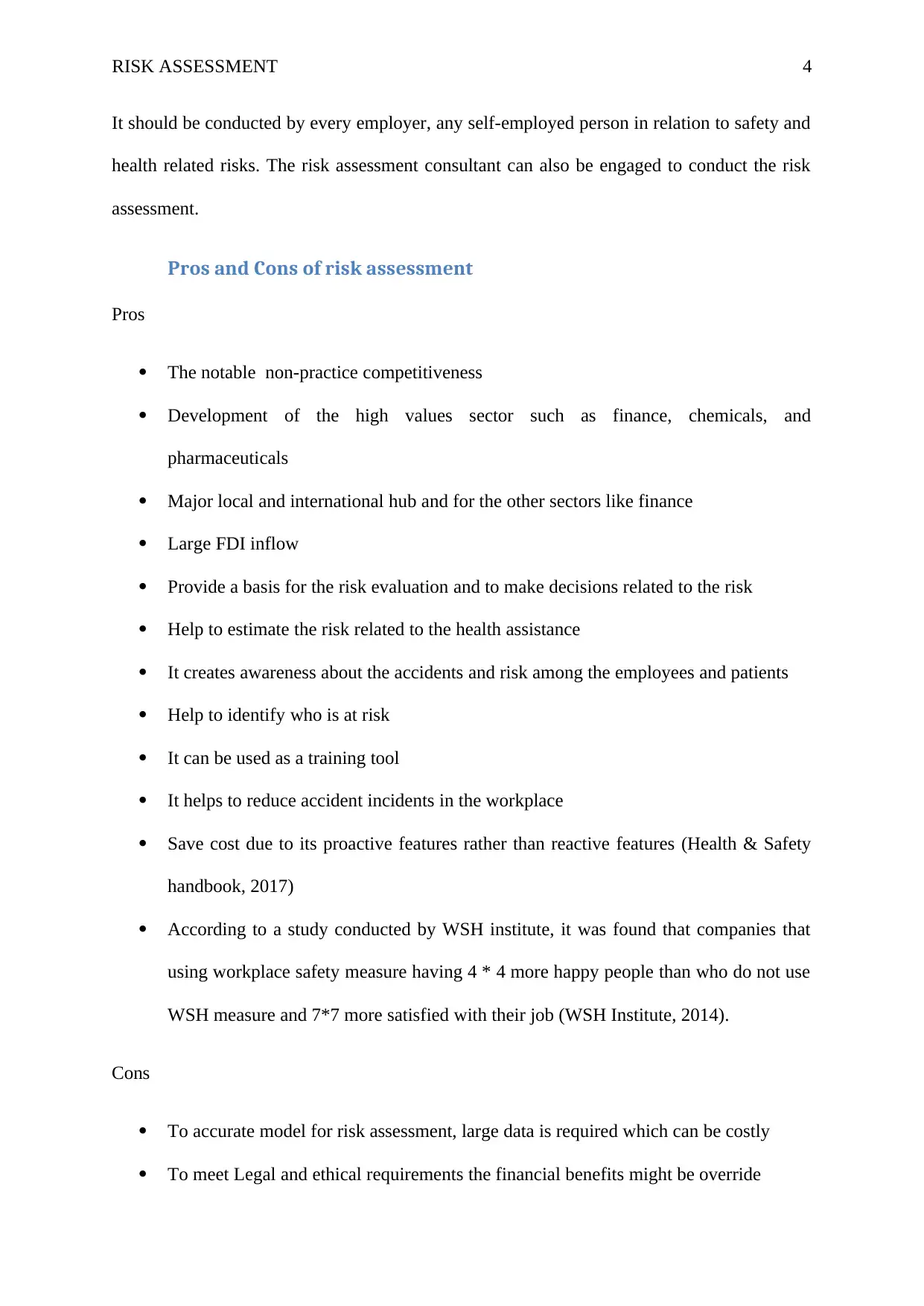
RISK ASSESSMENT 4
It should be conducted by every employer, any self-employed person in relation to safety and
health related risks. The risk assessment consultant can also be engaged to conduct the risk
assessment.
Pros and Cons of risk assessment
Pros
The notable non-practice competitiveness
Development of the high values sector such as finance, chemicals, and
pharmaceuticals
Major local and international hub and for the other sectors like finance
Large FDI inflow
Provide a basis for the risk evaluation and to make decisions related to the risk
Help to estimate the risk related to the health assistance
It creates awareness about the accidents and risk among the employees and patients
Help to identify who is at risk
It can be used as a training tool
It helps to reduce accident incidents in the workplace
Save cost due to its proactive features rather than reactive features (Health & Safety
handbook, 2017)
According to a study conducted by WSH institute, it was found that companies that
using workplace safety measure having 4 * 4 more happy people than who do not use
WSH measure and 7*7 more satisfied with their job (WSH Institute, 2014).
Cons
To accurate model for risk assessment, large data is required which can be costly
To meet Legal and ethical requirements the financial benefits might be override
It should be conducted by every employer, any self-employed person in relation to safety and
health related risks. The risk assessment consultant can also be engaged to conduct the risk
assessment.
Pros and Cons of risk assessment
Pros
The notable non-practice competitiveness
Development of the high values sector such as finance, chemicals, and
pharmaceuticals
Major local and international hub and for the other sectors like finance
Large FDI inflow
Provide a basis for the risk evaluation and to make decisions related to the risk
Help to estimate the risk related to the health assistance
It creates awareness about the accidents and risk among the employees and patients
Help to identify who is at risk
It can be used as a training tool
It helps to reduce accident incidents in the workplace
Save cost due to its proactive features rather than reactive features (Health & Safety
handbook, 2017)
According to a study conducted by WSH institute, it was found that companies that
using workplace safety measure having 4 * 4 more happy people than who do not use
WSH measure and 7*7 more satisfied with their job (WSH Institute, 2014).
Cons
To accurate model for risk assessment, large data is required which can be costly
To meet Legal and ethical requirements the financial benefits might be override
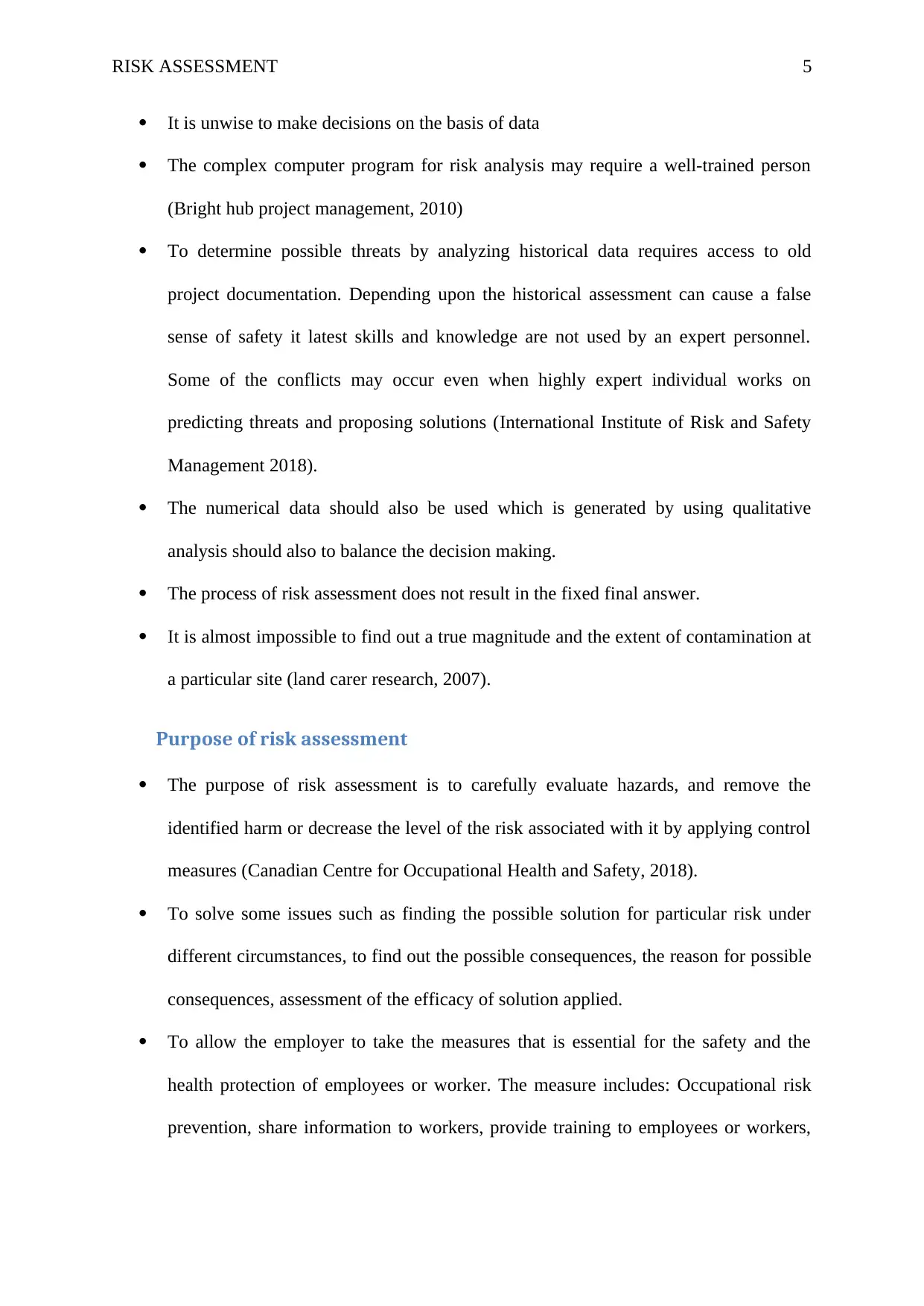
RISK ASSESSMENT 5
It is unwise to make decisions on the basis of data
The complex computer program for risk analysis may require a well-trained person
(Bright hub project management, 2010)
To determine possible threats by analyzing historical data requires access to old
project documentation. Depending upon the historical assessment can cause a false
sense of safety it latest skills and knowledge are not used by an expert personnel.
Some of the conflicts may occur even when highly expert individual works on
predicting threats and proposing solutions (International Institute of Risk and Safety
Management 2018).
The numerical data should also be used which is generated by using qualitative
analysis should also to balance the decision making.
The process of risk assessment does not result in the fixed final answer.
It is almost impossible to find out a true magnitude and the extent of contamination at
a particular site (land carer research, 2007).
Purpose of risk assessment
The purpose of risk assessment is to carefully evaluate hazards, and remove the
identified harm or decrease the level of the risk associated with it by applying control
measures (Canadian Centre for Occupational Health and Safety, 2018).
To solve some issues such as finding the possible solution for particular risk under
different circumstances, to find out the possible consequences, the reason for possible
consequences, assessment of the efficacy of solution applied.
To allow the employer to take the measures that is essential for the safety and the
health protection of employees or worker. The measure includes: Occupational risk
prevention, share information to workers, provide training to employees or workers,
It is unwise to make decisions on the basis of data
The complex computer program for risk analysis may require a well-trained person
(Bright hub project management, 2010)
To determine possible threats by analyzing historical data requires access to old
project documentation. Depending upon the historical assessment can cause a false
sense of safety it latest skills and knowledge are not used by an expert personnel.
Some of the conflicts may occur even when highly expert individual works on
predicting threats and proposing solutions (International Institute of Risk and Safety
Management 2018).
The numerical data should also be used which is generated by using qualitative
analysis should also to balance the decision making.
The process of risk assessment does not result in the fixed final answer.
It is almost impossible to find out a true magnitude and the extent of contamination at
a particular site (land carer research, 2007).
Purpose of risk assessment
The purpose of risk assessment is to carefully evaluate hazards, and remove the
identified harm or decrease the level of the risk associated with it by applying control
measures (Canadian Centre for Occupational Health and Safety, 2018).
To solve some issues such as finding the possible solution for particular risk under
different circumstances, to find out the possible consequences, the reason for possible
consequences, assessment of the efficacy of solution applied.
To allow the employer to take the measures that is essential for the safety and the
health protection of employees or worker. The measure includes: Occupational risk
prevention, share information to workers, provide training to employees or workers,
⊘ This is a preview!⊘
Do you want full access?
Subscribe today to unlock all pages.

Trusted by 1+ million students worldwide
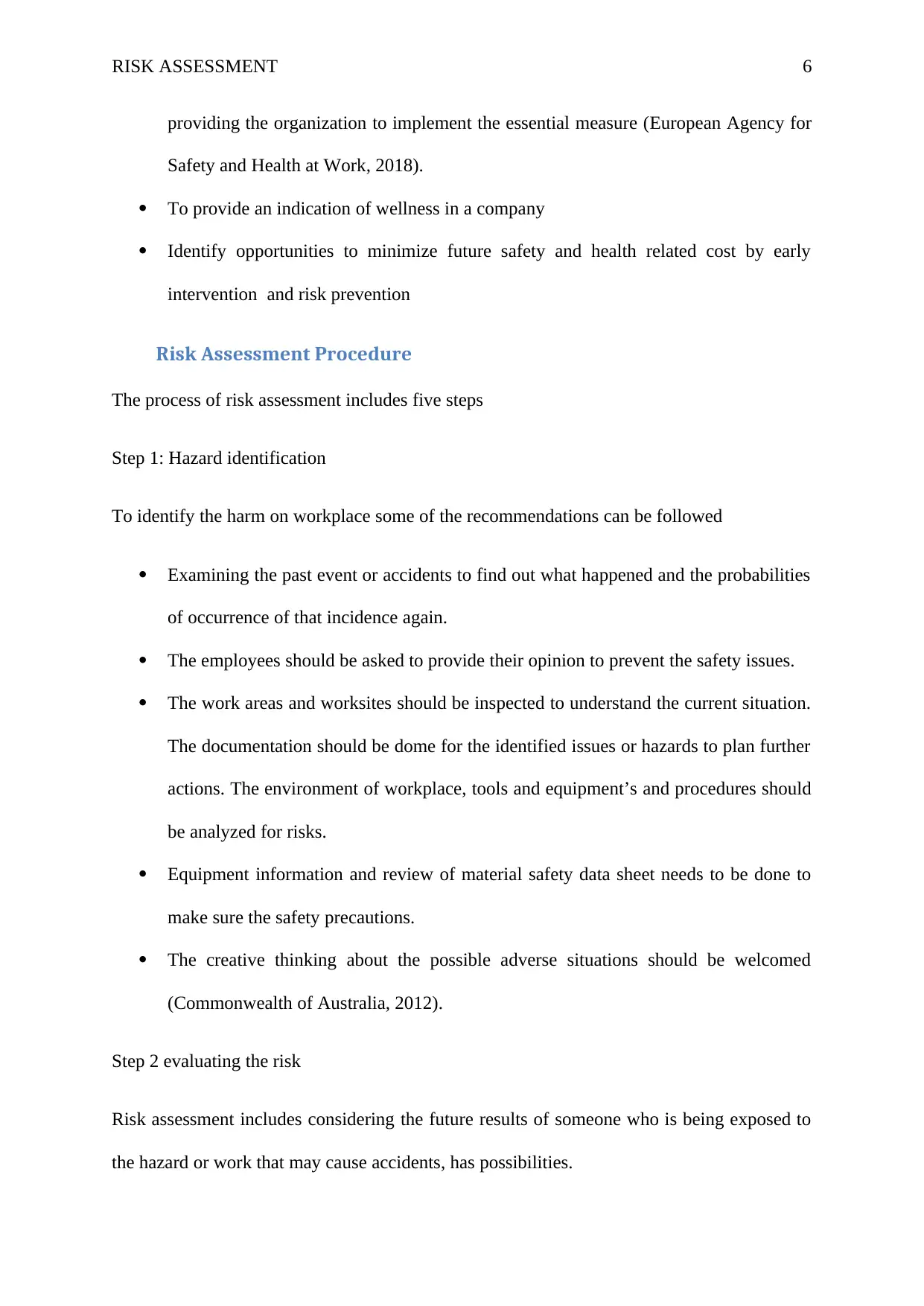
RISK ASSESSMENT 6
providing the organization to implement the essential measure (European Agency for
Safety and Health at Work, 2018).
To provide an indication of wellness in a company
Identify opportunities to minimize future safety and health related cost by early
intervention and risk prevention
Risk Assessment Procedure
The process of risk assessment includes five steps
Step 1: Hazard identification
To identify the harm on workplace some of the recommendations can be followed
Examining the past event or accidents to find out what happened and the probabilities
of occurrence of that incidence again.
The employees should be asked to provide their opinion to prevent the safety issues.
The work areas and worksites should be inspected to understand the current situation.
The documentation should be dome for the identified issues or hazards to plan further
actions. The environment of workplace, tools and equipment’s and procedures should
be analyzed for risks.
Equipment information and review of material safety data sheet needs to be done to
make sure the safety precautions.
The creative thinking about the possible adverse situations should be welcomed
(Commonwealth of Australia, 2012).
Step 2 evaluating the risk
Risk assessment includes considering the future results of someone who is being exposed to
the hazard or work that may cause accidents, has possibilities.
providing the organization to implement the essential measure (European Agency for
Safety and Health at Work, 2018).
To provide an indication of wellness in a company
Identify opportunities to minimize future safety and health related cost by early
intervention and risk prevention
Risk Assessment Procedure
The process of risk assessment includes five steps
Step 1: Hazard identification
To identify the harm on workplace some of the recommendations can be followed
Examining the past event or accidents to find out what happened and the probabilities
of occurrence of that incidence again.
The employees should be asked to provide their opinion to prevent the safety issues.
The work areas and worksites should be inspected to understand the current situation.
The documentation should be dome for the identified issues or hazards to plan further
actions. The environment of workplace, tools and equipment’s and procedures should
be analyzed for risks.
Equipment information and review of material safety data sheet needs to be done to
make sure the safety precautions.
The creative thinking about the possible adverse situations should be welcomed
(Commonwealth of Australia, 2012).
Step 2 evaluating the risk
Risk assessment includes considering the future results of someone who is being exposed to
the hazard or work that may cause accidents, has possibilities.
Paraphrase This Document
Need a fresh take? Get an instant paraphrase of this document with our AI Paraphraser
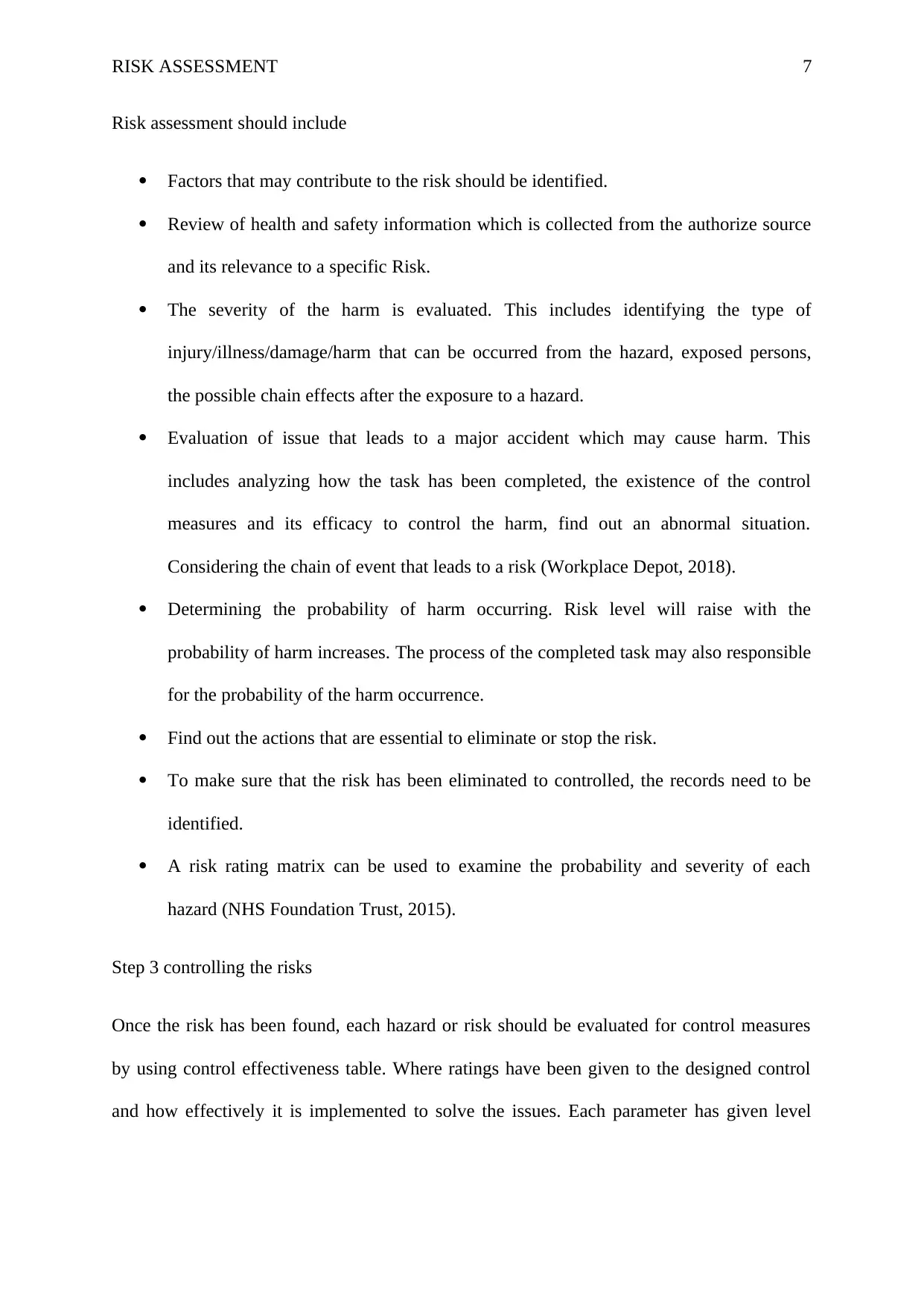
RISK ASSESSMENT 7
Risk assessment should include
Factors that may contribute to the risk should be identified.
Review of health and safety information which is collected from the authorize source
and its relevance to a specific Risk.
The severity of the harm is evaluated. This includes identifying the type of
injury/illness/damage/harm that can be occurred from the hazard, exposed persons,
the possible chain effects after the exposure to a hazard.
Evaluation of issue that leads to a major accident which may cause harm. This
includes analyzing how the task has been completed, the existence of the control
measures and its efficacy to control the harm, find out an abnormal situation.
Considering the chain of event that leads to a risk (Workplace Depot, 2018).
Determining the probability of harm occurring. Risk level will raise with the
probability of harm increases. The process of the completed task may also responsible
for the probability of the harm occurrence.
Find out the actions that are essential to eliminate or stop the risk.
To make sure that the risk has been eliminated to controlled, the records need to be
identified.
A risk rating matrix can be used to examine the probability and severity of each
hazard (NHS Foundation Trust, 2015).
Step 3 controlling the risks
Once the risk has been found, each hazard or risk should be evaluated for control measures
by using control effectiveness table. Where ratings have been given to the designed control
and how effectively it is implemented to solve the issues. Each parameter has given level
Risk assessment should include
Factors that may contribute to the risk should be identified.
Review of health and safety information which is collected from the authorize source
and its relevance to a specific Risk.
The severity of the harm is evaluated. This includes identifying the type of
injury/illness/damage/harm that can be occurred from the hazard, exposed persons,
the possible chain effects after the exposure to a hazard.
Evaluation of issue that leads to a major accident which may cause harm. This
includes analyzing how the task has been completed, the existence of the control
measures and its efficacy to control the harm, find out an abnormal situation.
Considering the chain of event that leads to a risk (Workplace Depot, 2018).
Determining the probability of harm occurring. Risk level will raise with the
probability of harm increases. The process of the completed task may also responsible
for the probability of the harm occurrence.
Find out the actions that are essential to eliminate or stop the risk.
To make sure that the risk has been eliminated to controlled, the records need to be
identified.
A risk rating matrix can be used to examine the probability and severity of each
hazard (NHS Foundation Trust, 2015).
Step 3 controlling the risks
Once the risk has been found, each hazard or risk should be evaluated for control measures
by using control effectiveness table. Where ratings have been given to the designed control
and how effectively it is implemented to solve the issues. Each parameter has given level
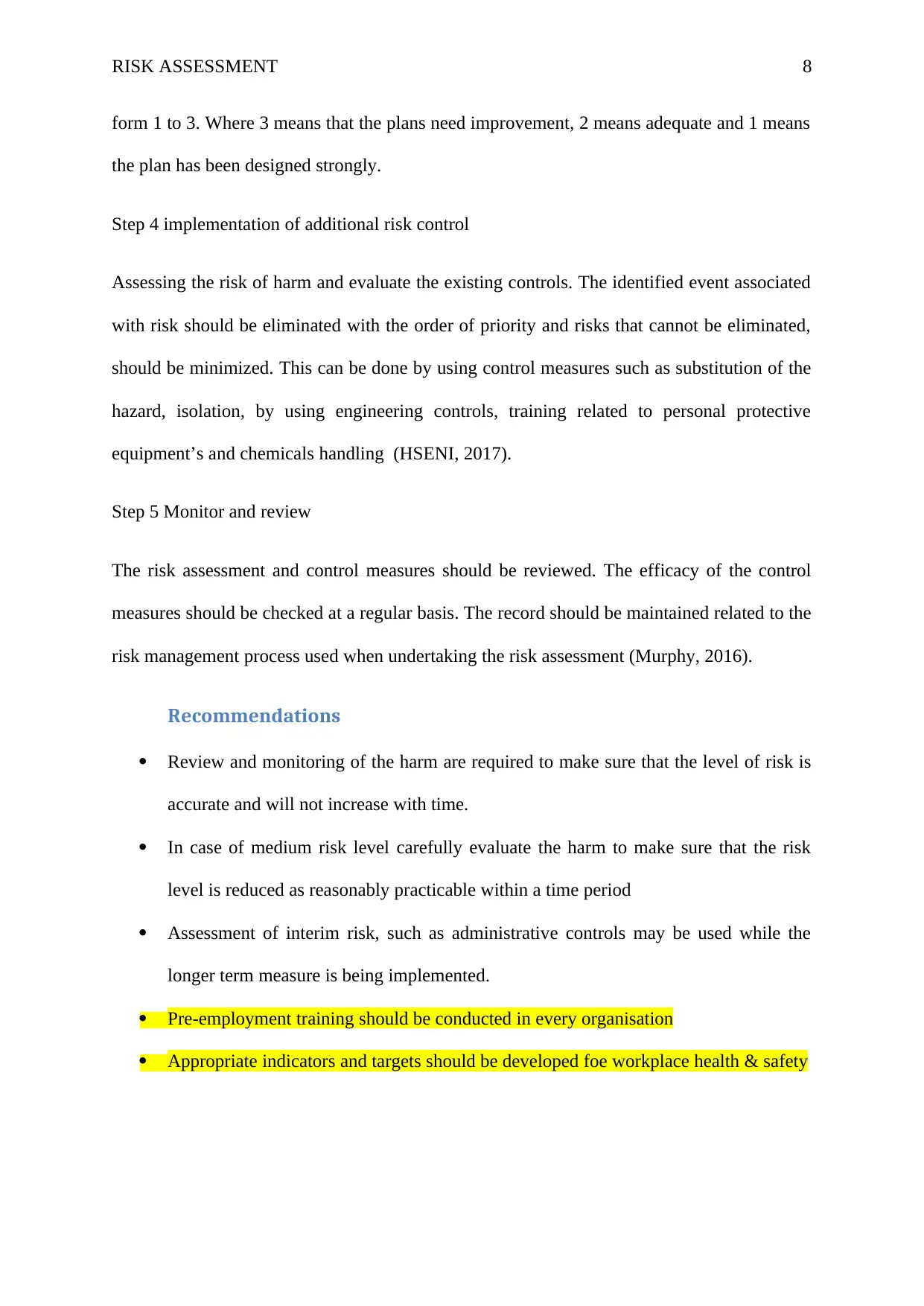
RISK ASSESSMENT 8
form 1 to 3. Where 3 means that the plans need improvement, 2 means adequate and 1 means
the plan has been designed strongly.
Step 4 implementation of additional risk control
Assessing the risk of harm and evaluate the existing controls. The identified event associated
with risk should be eliminated with the order of priority and risks that cannot be eliminated,
should be minimized. This can be done by using control measures such as substitution of the
hazard, isolation, by using engineering controls, training related to personal protective
equipment’s and chemicals handling (HSENI, 2017).
Step 5 Monitor and review
The risk assessment and control measures should be reviewed. The efficacy of the control
measures should be checked at a regular basis. The record should be maintained related to the
risk management process used when undertaking the risk assessment (Murphy, 2016).
Recommendations
Review and monitoring of the harm are required to make sure that the level of risk is
accurate and will not increase with time.
In case of medium risk level carefully evaluate the harm to make sure that the risk
level is reduced as reasonably practicable within a time period
Assessment of interim risk, such as administrative controls may be used while the
longer term measure is being implemented.
Pre-employment training should be conducted in every organisation
Appropriate indicators and targets should be developed foe workplace health & safety
form 1 to 3. Where 3 means that the plans need improvement, 2 means adequate and 1 means
the plan has been designed strongly.
Step 4 implementation of additional risk control
Assessing the risk of harm and evaluate the existing controls. The identified event associated
with risk should be eliminated with the order of priority and risks that cannot be eliminated,
should be minimized. This can be done by using control measures such as substitution of the
hazard, isolation, by using engineering controls, training related to personal protective
equipment’s and chemicals handling (HSENI, 2017).
Step 5 Monitor and review
The risk assessment and control measures should be reviewed. The efficacy of the control
measures should be checked at a regular basis. The record should be maintained related to the
risk management process used when undertaking the risk assessment (Murphy, 2016).
Recommendations
Review and monitoring of the harm are required to make sure that the level of risk is
accurate and will not increase with time.
In case of medium risk level carefully evaluate the harm to make sure that the risk
level is reduced as reasonably practicable within a time period
Assessment of interim risk, such as administrative controls may be used while the
longer term measure is being implemented.
Pre-employment training should be conducted in every organisation
Appropriate indicators and targets should be developed foe workplace health & safety
⊘ This is a preview!⊘
Do you want full access?
Subscribe today to unlock all pages.

Trusted by 1+ million students worldwide
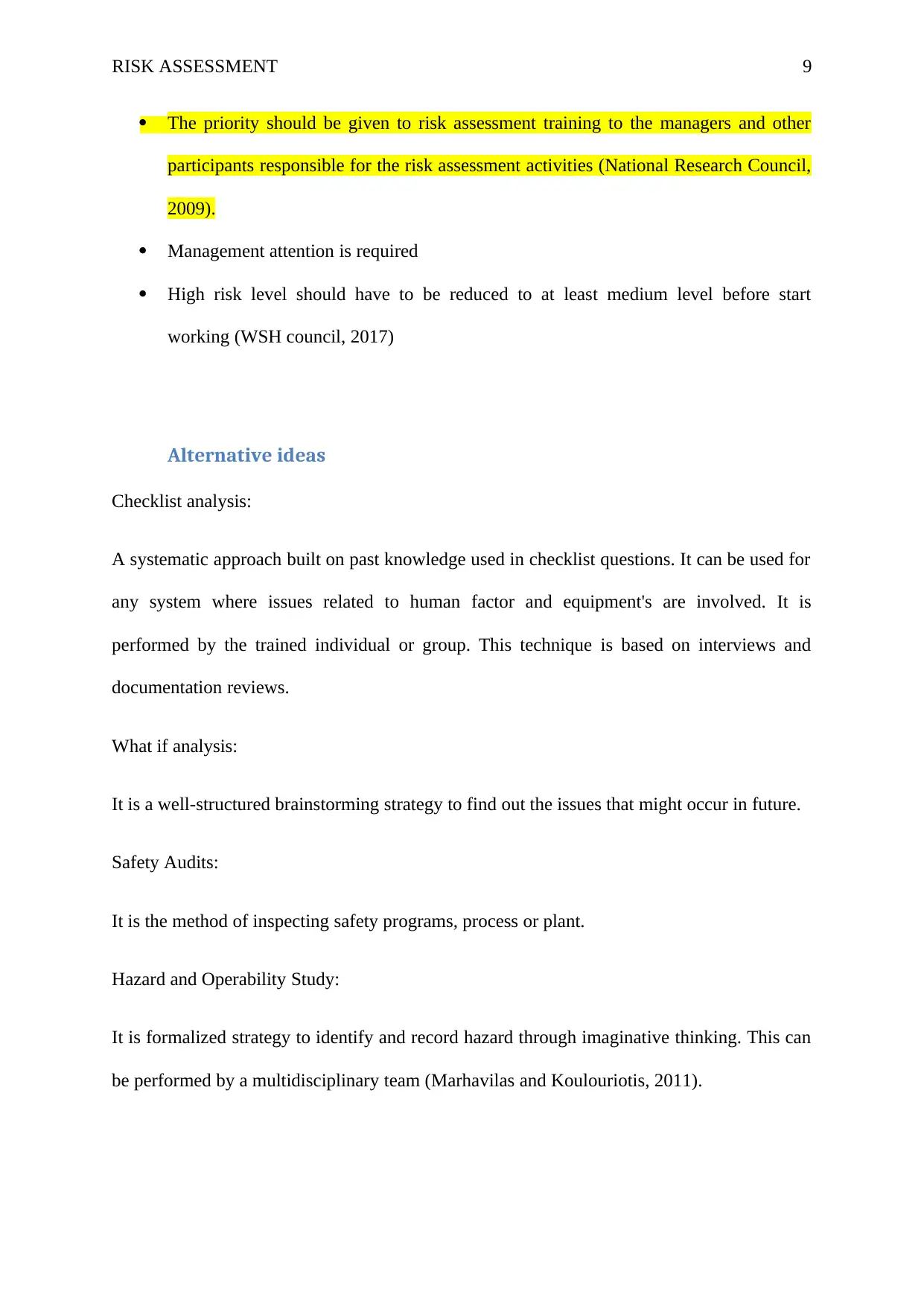
RISK ASSESSMENT 9
The priority should be given to risk assessment training to the managers and other
participants responsible for the risk assessment activities (National Research Council,
2009).
Management attention is required
High risk level should have to be reduced to at least medium level before start
working (WSH council, 2017)
Alternative ideas
Checklist analysis:
A systematic approach built on past knowledge used in checklist questions. It can be used for
any system where issues related to human factor and equipment's are involved. It is
performed by the trained individual or group. This technique is based on interviews and
documentation reviews.
What if analysis:
It is a well-structured brainstorming strategy to find out the issues that might occur in future.
Safety Audits:
It is the method of inspecting safety programs, process or plant.
Hazard and Operability Study:
It is formalized strategy to identify and record hazard through imaginative thinking. This can
be performed by a multidisciplinary team (Marhavilas and Koulouriotis, 2011).
The priority should be given to risk assessment training to the managers and other
participants responsible for the risk assessment activities (National Research Council,
2009).
Management attention is required
High risk level should have to be reduced to at least medium level before start
working (WSH council, 2017)
Alternative ideas
Checklist analysis:
A systematic approach built on past knowledge used in checklist questions. It can be used for
any system where issues related to human factor and equipment's are involved. It is
performed by the trained individual or group. This technique is based on interviews and
documentation reviews.
What if analysis:
It is a well-structured brainstorming strategy to find out the issues that might occur in future.
Safety Audits:
It is the method of inspecting safety programs, process or plant.
Hazard and Operability Study:
It is formalized strategy to identify and record hazard through imaginative thinking. This can
be performed by a multidisciplinary team (Marhavilas and Koulouriotis, 2011).
Paraphrase This Document
Need a fresh take? Get an instant paraphrase of this document with our AI Paraphraser
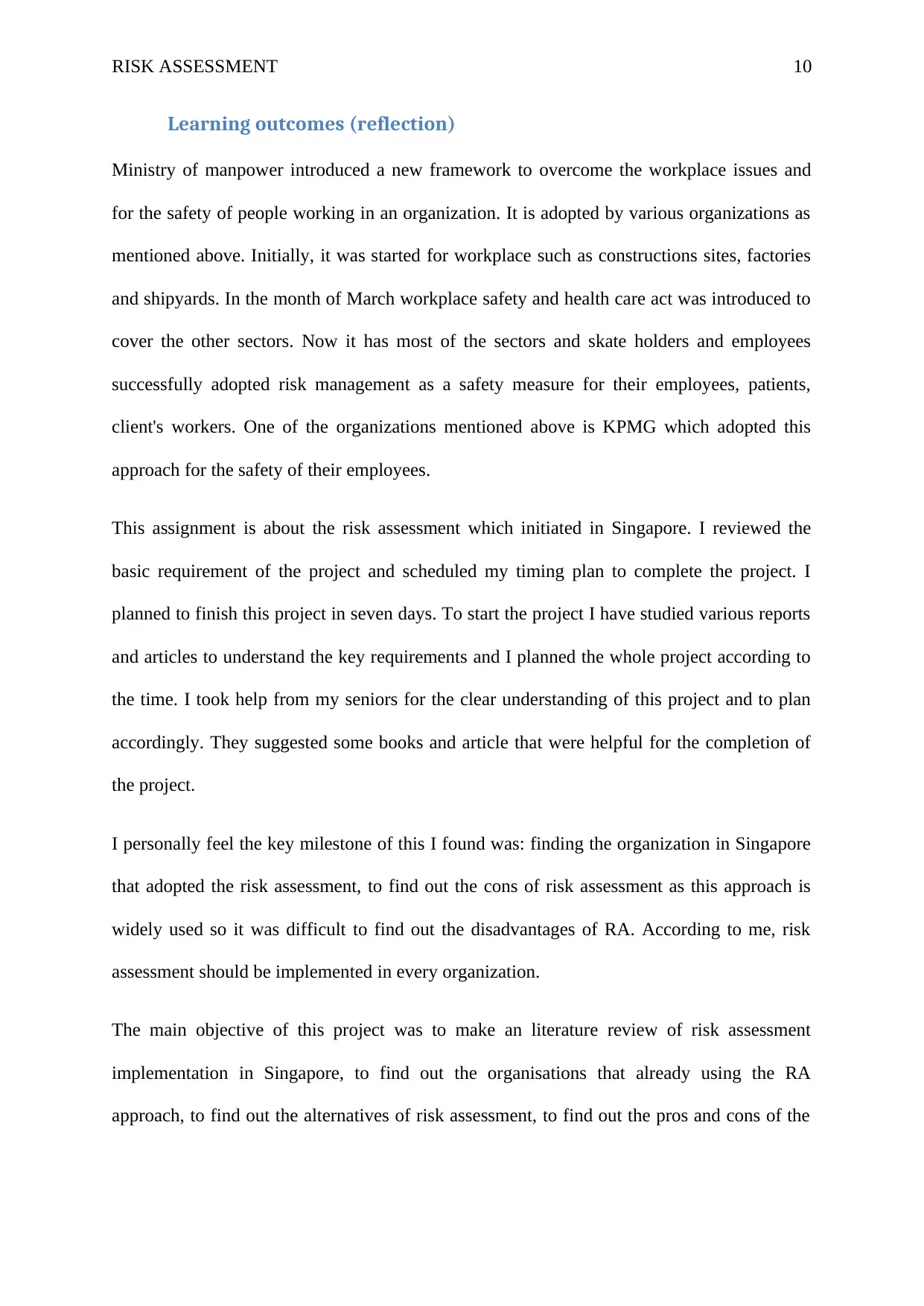
RISK ASSESSMENT 10
Learning outcomes (reflection)
Ministry of manpower introduced a new framework to overcome the workplace issues and
for the safety of people working in an organization. It is adopted by various organizations as
mentioned above. Initially, it was started for workplace such as constructions sites, factories
and shipyards. In the month of March workplace safety and health care act was introduced to
cover the other sectors. Now it has most of the sectors and skate holders and employees
successfully adopted risk management as a safety measure for their employees, patients,
client's workers. One of the organizations mentioned above is KPMG which adopted this
approach for the safety of their employees.
This assignment is about the risk assessment which initiated in Singapore. I reviewed the
basic requirement of the project and scheduled my timing plan to complete the project. I
planned to finish this project in seven days. To start the project I have studied various reports
and articles to understand the key requirements and I planned the whole project according to
the time. I took help from my seniors for the clear understanding of this project and to plan
accordingly. They suggested some books and article that were helpful for the completion of
the project.
I personally feel the key milestone of this I found was: finding the organization in Singapore
that adopted the risk assessment, to find out the cons of risk assessment as this approach is
widely used so it was difficult to find out the disadvantages of RA. According to me, risk
assessment should be implemented in every organization.
The main objective of this project was to make an literature review of risk assessment
implementation in Singapore, to find out the organisations that already using the RA
approach, to find out the alternatives of risk assessment, to find out the pros and cons of the
Learning outcomes (reflection)
Ministry of manpower introduced a new framework to overcome the workplace issues and
for the safety of people working in an organization. It is adopted by various organizations as
mentioned above. Initially, it was started for workplace such as constructions sites, factories
and shipyards. In the month of March workplace safety and health care act was introduced to
cover the other sectors. Now it has most of the sectors and skate holders and employees
successfully adopted risk management as a safety measure for their employees, patients,
client's workers. One of the organizations mentioned above is KPMG which adopted this
approach for the safety of their employees.
This assignment is about the risk assessment which initiated in Singapore. I reviewed the
basic requirement of the project and scheduled my timing plan to complete the project. I
planned to finish this project in seven days. To start the project I have studied various reports
and articles to understand the key requirements and I planned the whole project according to
the time. I took help from my seniors for the clear understanding of this project and to plan
accordingly. They suggested some books and article that were helpful for the completion of
the project.
I personally feel the key milestone of this I found was: finding the organization in Singapore
that adopted the risk assessment, to find out the cons of risk assessment as this approach is
widely used so it was difficult to find out the disadvantages of RA. According to me, risk
assessment should be implemented in every organization.
The main objective of this project was to make an literature review of risk assessment
implementation in Singapore, to find out the organisations that already using the RA
approach, to find out the alternatives of risk assessment, to find out the pros and cons of the
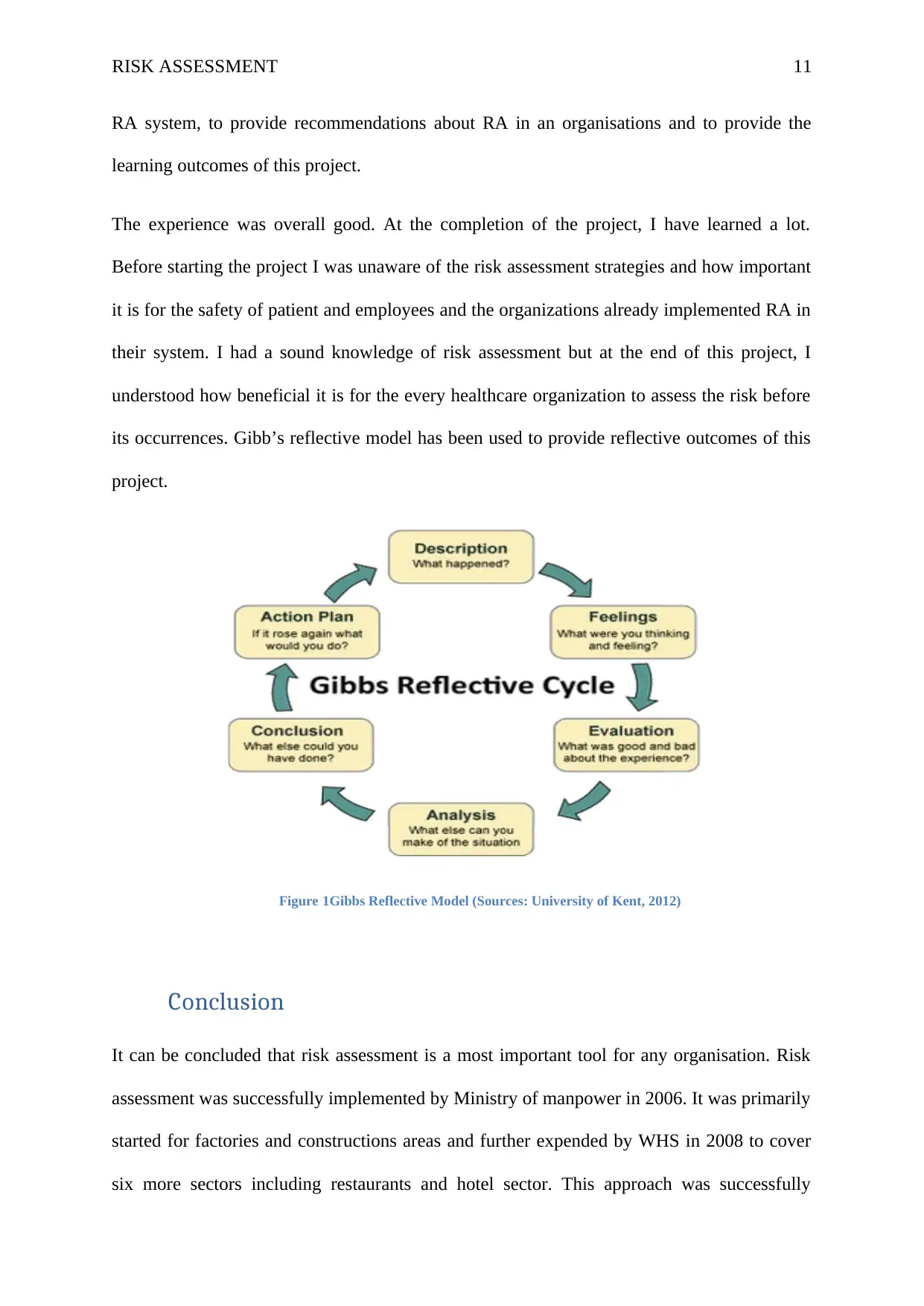
RISK ASSESSMENT 11
RA system, to provide recommendations about RA in an organisations and to provide the
learning outcomes of this project.
The experience was overall good. At the completion of the project, I have learned a lot.
Before starting the project I was unaware of the risk assessment strategies and how important
it is for the safety of patient and employees and the organizations already implemented RA in
their system. I had a sound knowledge of risk assessment but at the end of this project, I
understood how beneficial it is for the every healthcare organization to assess the risk before
its occurrences. Gibb’s reflective model has been used to provide reflective outcomes of this
project.
Figure 1Gibbs Reflective Model (Sources: University of Kent, 2012)
Conclusion
It can be concluded that risk assessment is a most important tool for any organisation. Risk
assessment was successfully implemented by Ministry of manpower in 2006. It was primarily
started for factories and constructions areas and further expended by WHS in 2008 to cover
six more sectors including restaurants and hotel sector. This approach was successfully
RA system, to provide recommendations about RA in an organisations and to provide the
learning outcomes of this project.
The experience was overall good. At the completion of the project, I have learned a lot.
Before starting the project I was unaware of the risk assessment strategies and how important
it is for the safety of patient and employees and the organizations already implemented RA in
their system. I had a sound knowledge of risk assessment but at the end of this project, I
understood how beneficial it is for the every healthcare organization to assess the risk before
its occurrences. Gibb’s reflective model has been used to provide reflective outcomes of this
project.
Figure 1Gibbs Reflective Model (Sources: University of Kent, 2012)
Conclusion
It can be concluded that risk assessment is a most important tool for any organisation. Risk
assessment was successfully implemented by Ministry of manpower in 2006. It was primarily
started for factories and constructions areas and further expended by WHS in 2008 to cover
six more sectors including restaurants and hotel sector. This approach was successfully
⊘ This is a preview!⊘
Do you want full access?
Subscribe today to unlock all pages.

Trusted by 1+ million students worldwide
1 out of 17
Related Documents
Your All-in-One AI-Powered Toolkit for Academic Success.
+13062052269
info@desklib.com
Available 24*7 on WhatsApp / Email
![[object Object]](/_next/static/media/star-bottom.7253800d.svg)
Unlock your academic potential
Copyright © 2020–2025 A2Z Services. All Rights Reserved. Developed and managed by ZUCOL.





